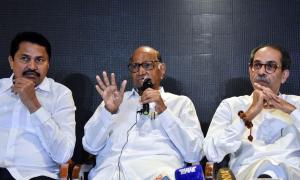How many brands must a marketeer ideally have in his portfolio? How many distinct consumer segments exist in a market? How many distinct consumer benefits can be offered in any product category? These are million dollar questions that marketers are constantly seeking answers for.
Every new brand attempts to find a new benefit and hence a distinct consumer segment to address, hoping to get a share from existing brands in the market. And only time tells whether the segment (and brand) is sustainable in the long run.
At one level, the world can be looked upon as one big market -- homogeneous mass of 6 billion people -- all being human beings at a base level -- with the same basic physiological needs and wants.
At the other extreme, if we accept that no two individuals are the same, then the market can be divided into six billion segments. So there can be only one brand or there could be six billion! Both are conceptually true but the reality, practical truth, is perhaps some where in-between.
Historically, in India, the fast moving consumer goods category has been dominated by multinationals like Unilever, Nestle, P&G and Cadbury's. They have philosophically believed in a multi-brand approach, launching distinct brands in every new category they've entered and often offering multiple brands within a category at different price points and formats.
Colgate Palmolive and Kelloggs have, however, taken the single brand approach. Consumer durables, on the other hand, have traditionally gone towards the single master brand approach -- getting the corporate brand to sell a range of products from TVs to refrigerators to air conditioners to washing machines. Godrej, BPL, Onida, Samsung and LG are examples of the same.
Whatever has been the reason for evolution, not surprisingly, many FMCG marketers -- multinational and local -- in India have ended up with a plethora of brands of varying sizes and equities.
It is in this context that Levers' current concepts of 'power' brands and 'master' brands need to be seen and understood. While they could be an attempt to handle the tough markets Unilever is operating in, the larger canvas of these concepts is a lesson in brand management.
Companies end with a plethora of brands for a number of reasons:
Mergers and Acquisitions: Companies often grow by taking over competitors -- while doing so they take over competing brands too. Often, the taken over brand has a direct competitor in the mother company's stable.
The obvious solution is rationalisation -- i.e. merge the taken over brand with the mother one. However while corporate takeovers are relatively simple (pay a price and get the legal work done), the consumer takeover is not so easy. The taken-over brand often has its own reasonable volume and brand equity, which, if touched, could effect results in the short run. Often the brand is retained and allowed to float within the system.
Current understanding of consumer segments: New launches are often based on professional market studies of consumer segmentation based on benefits or values. Such studies throw up new opportunities, which if tapped dictate the launch of a new offering in the category. The marketeer may decide it to be a current brand or a new one -- depending on the opportunity and the equities of the current brands.
Perception of brand elasticity: This is the most complicated yet real reason for the launch of new brands. In the '70s and early '80s, new delivery forms (detergent powders and bars) drove new brand introductions. And constant fear that new introductions will harm the mother brand drives marketers to launch a new brand.
What could have been variants ends up as new brands. (There are still relatively few takers for Richard Branson's view that a brand's elasticity is as much as you stretch it. He sees no limit to it. So Virgin sells airlines and music and condoms under one name -- and supposedly successfully).
There is also this constant belief that FMCGs are different from consumer durables and so the branding lessons cannot be transferred- though the consumers often buying into the two categories are the same!
Tactical launches: This could be a surrogate for (c) but sometimes, new brands are introduced to combat a competitor at the local level with a local positioning -- with the full knowledge that it may not become a viable national brand. However, the brand takes its own shape and form and becomes a force nationally over years.
Organisation structures: Marketing departments are mostly structured by categories (product groups) and they often operate as silos. Brands are handled within these silos. New product opportunities, if not found appropriate for a brand within the category stable, end up with new name -- adding to the company portfolio. What could have been classic brand extensions end up being new brands!
Whatever the reasons, ultimately a marketeer lands up with a basket of brands. Three factors determine a need to rationalise and prioritise:
Limited resources: At any given point of time, a marketer's resources in terms of time, money and talent is limited. It is a strategic decision what to prioritise and focus on and what to defocus. 'Power' brands help to focus a company's limited resources on more profitable brands.
The evolving consumer: Markets are not static nor are consumers. They are changing all the time -- their expectations getting redefined by the market offerings, their experiences with the offerings and their exposures abroad. Segments that existed a decade ago would have vanished today.
Benefits that were differentiating earlier are now necessities. Brands need to continuously understand this and reinvent themselves. In such scenarios, in a portfolio, two brand benefits could merge and become one -- and thus one could get redundant. 'Master brands' help to manage multiple benefits under one big name and thus bring economies of brand building.
Consolidation: In any on going portfolio, there are going to be brands of varying sizes. While the larger ones could be self-sustaining and smaller ones ignorable, the 'mid' ones are problem children.
Neither can they stand on their own nor can they be neglected because of their current volumes and value. Master brands can be used to help migrate such brands under them. (The recent Rexona to Lux transition is an attempt in that direction.)
In sum, brand portfolio management is a game. No portfolio is final as no brand is final. It is a continuous process of evolution -- something that needs to constantly re-engineer itself to changing consumer needs and demands. Not surprisingly, Unilever's call for focusing on 'power' brands has suddenly become a buzz word within the marketing world today -- with all FMCG marketers using it to drive their growth initiatives in the future.
The mantra for the future will be 'fewer the better'. Gone are the days when marketers could afford the luxury of creating new equities for every new opportunity. The trick will be to tap new opportunities within the constraints (or with the advantage of) current brand equities. And simultaneously build robust 'master' brands that can support a myriad of productsacross categories.
Something worth thinking about.







More from rediff